8.2 Ratio and proportion
|
Previous
8.1 Revision
|
Next
8.3 Polygons
|
8.2 Ratio and proportion (EMCJ8)
Ratio
A ratio describes the relationship between two quantities which have the same units. We can use ratios to compare weights, heights, lengths, currencies, etc. A ratio is a comparison between two quantities of the same kind and has no units.
Example: if the length of a rectangle is \(\text{20}\) \(\text{cm}\) and the width is \(\text{60}\) \(\text{cm}\), then we can express the ratio between the length and width of the rectangle as:
\begin{align*} \text{length to width } &= 20 \text{ to } 60 \\ &= 1 \text{ to } 3 \\ & \\ \text {Or } \quad \frac{\text{length}}{\text{width}} &= \frac{20}{60} \\ &= \frac{1}{3} \\ & \\ \text {Or } \quad \text{length} : \text{width } &= 20: 60 \\ &= 1: 3 \end{align*}- The ratio of \(\frac{1}{3}\) describes the length of the rectangle relative to its width.
- A ratio written as a fraction is usually given in its simplest form.
-
A ratio gives no indication of actual length. For example,
\[\frac{\text{length}}{\text{width}} = \frac{\text{50}\text{ cm}}{\text{150}\text{ cm}} \enspace \text{also gives a ratio of} \enspace \frac{1}{3}\] \[\text{And} \enspace \frac{\text{length}}{\text{width}} = \frac{\text{0,8}\text{ m}}{\text{2,4}\text{ m}} \enspace \text{also gives a ratio of} \enspace \frac{1}{3}\] - Do not convert a ratio to a decimal (even though \(\frac{1}{3}\) and \(\text{0,}\dot{3}\) have the same numerical value).
Proportion
Predicting heights
A record of heights is given.
If the ratio \(\frac{\text{height of a person at two years old}} {\text{height of a person as an adult}}\) is \(\text{1}\) to \(\text{2}\), complete the table below:
| Name | Height at two years | Height as an adult |
| Hendrik | \(\text{84}\) \(\text{cm}\) | |
| Kagiso | \(\text{162}\) \(\text{cm}\) | |
| Linda | \(\text{86}\) \(\text{cm}\) | |
| Mandisa | \(\text{0,87}\) \(\text{m}\) | |
| Prashna | \(\text{1}\) \(\text{m}\) \(\text{64}\) \(\text{cm}\) |
Consider the diagram below:
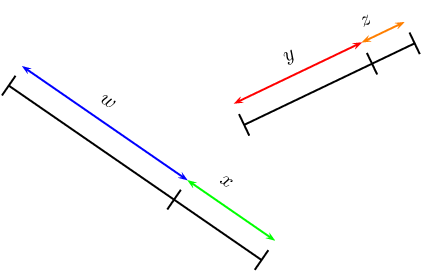
If two or more ratios are equal to each other, then we say that they are in the same proportion. Proportionality describes the equality of ratios.
If \(\dfrac{w}{x} = \dfrac{y}{z}\), then \(w\) and \(x\) are in the same proportion as \(y\) and \(z\).
- \(wz = xy\)
- \(\dfrac{x}{w} = \dfrac{z}{y}\)
- \(\dfrac{w}{y} = \dfrac{x}{z}\)
- \(\dfrac{y}{w} = \dfrac{z}{x}\)
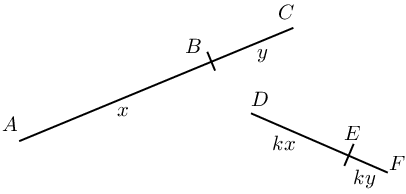
Given
\[\frac{AB}{BC}=\frac{x}{y}=\frac{kx}{ky}=\frac{DE}{EF}\]The line segments \(AB\) and \(BC\) are in the same proportion as \(DE\) and \(EF\). The following statements are also true:
| Proportion | Reciprocal proportion | Cross multiplication |
| \(\frac{AB}{BC}=\frac{DE}{FE}\) | \(\frac{BC}{AB}=\frac{FE}{DE}\) | \(AB \cdot FE = BC \cdot DE\) |
| \(\frac{AB}{AC}=\frac{DE}{DF}\) | \(\frac{AC}{AB}=\frac{DF}{DE}\) | \(AB \cdot DF = AC \cdot DE\) |
| \(\frac{BC}{AC}=\frac{EF}{DF}\) | \(\frac{AC}{BC}=\frac{DF}{EF}\) | \(BC \cdot DF = AC \cdot EF\) |
We can also substitute \(x\), \(y\), \(kx\), and \(ky\) to show algebraically that the statements are true.
For example,
\begin{align*} BC \cdot DF &= y \times (kx + ky) \\ &= ky (x + y) \\ \text{And } AC \cdot EF &= (x+y) \times ky \\ &= ky(x+y) \\ \therefore BC \cdot DF &= AC \cdot EF \end{align*}Ratio and proportion
Solve for \(p\):
A packet of \(\text{160}\) sweets contains red, blue and yellow sweets in the ratio of \(3:2:3\) respectively. Determine how many sweets of each colour there are in the packet.
A mixture contains \(\text{2}\) parts of substance \(A\) for every \(\text{5}\) parts of substance \(B\). If the total weight of the mixture is \(\text{50}\) \(\text{kg}\), determine how much of substance \(B\) is in the mixture (correct to \(\text{2}\) decimal places).
Given the diagram below.
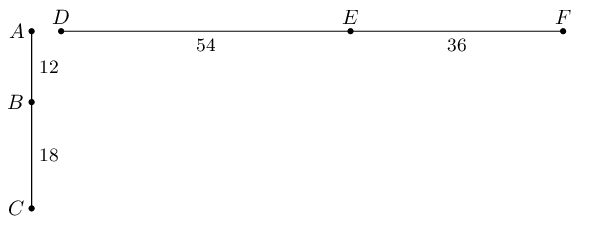
Show that:
Consider the line segment shown below.

Express the following in terms of \(a\) and \(b\):
\(ABCD\) is a parallelogram with \(DC = \text{15}\text{ cm}\), \(h = \text{8}\text{ cm}\) and \(BF = \text{9}\text{ cm}\).
Calculate the ratio \(\dfrac{\text{area } ABF}{\text{area } ABCD}\).
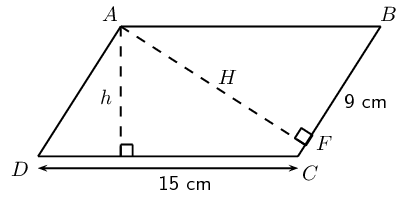
The area of a parallelogram \(ABCD =\) base \(\times\) height:
\begin{align*} \text{Area} &= \text{15} \times \text{8} \\ &= \text{120}\text{ cm$^{2}$} \end{align*}The perimeter of a parallelogram \(ABCD = 2DC + 2BC\).
To find the length of \(AF\), we use \(AF \perp BC\) and the theorem of Pythagoras.
\begin{align*} \text{In \(\triangle ABF\):} \quad AF^2 &= AB^2 - BF^2 \\ &= \text{15}^2 - \text{9}^2 \\ &= \text{144} \\ \therefore AF &= \text{12}\text{ cm} \\ \therefore \text{area } ABF &= \frac{1}{2} AF \cdot BF \\ &= \frac{1}{2}(12)(9)\\ &= \text{54}\text{ cm} \end{align*} \begin{align*} \therefore \frac{\text{area } ABF}{\text{area } ABCD} &= \frac{54}{120} \\ &= \frac{9}{20} \end{align*}\(AB = \text{36}\text{ m}\) and \(C\) divides \(AB\) in the ratio \(4:5\). Determine \(AC\) and \(CB\).
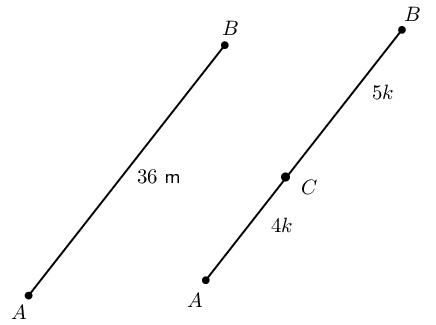
If \(PQ = \text{45}\text{ mm}\) and the ratio of \(TQ:PQ\) is \(2:3\), calculate \(PT\) and \(TQ\).
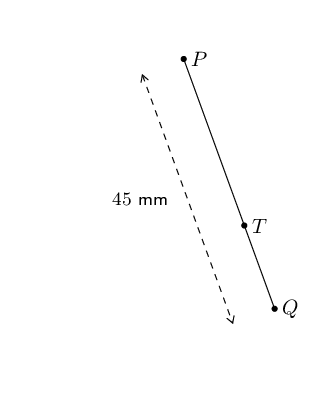
Luke's biology notebook is \(\text{30}\) \(\text{cm}\) long and \(\text{20}\) \(\text{cm}\) wide. The dimensions of his desk are in the same proportion as the dimensions of his notebook.
If the desk is \(\text{90}\text{ cm}\) wide, calculate the area of the top of the desk.
Luke covers each corner of his desk with an isosceles triangle of cardboard, as shown in the diagram:

Calculate the new perimeter and area of the visible part of the top of his desk.
|
Previous
8.1 Revision
|
Table of Contents |
Next
8.3 Polygons
|
